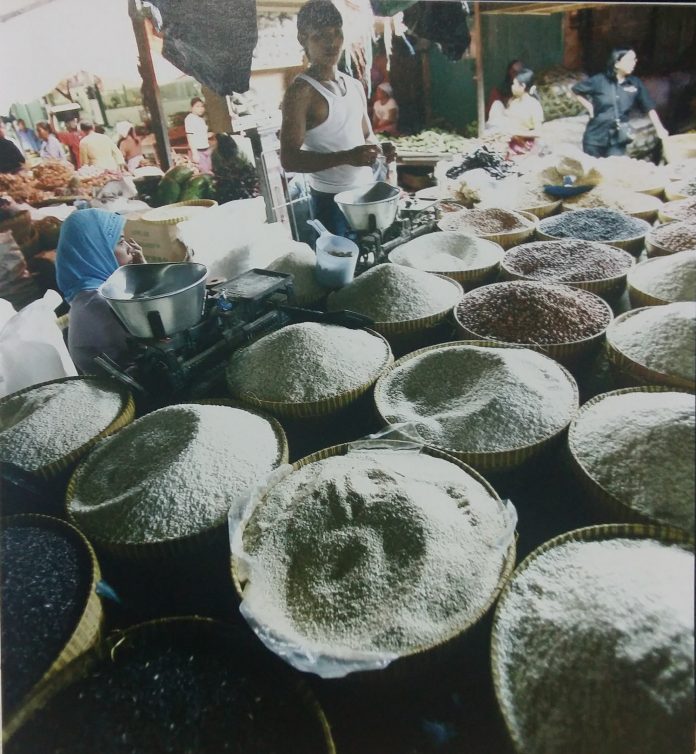Indonesia is recognized as the world’s largest archipelago, comprising over 17,000 islands, and covering a distance greater than that from Turkey to Russia. Its people speak more than 600 languages or dialects. Inevitably it also boasts an enormous number of traditions and cultural practices. Some describe Indonesia as the most diverse country in the world. Religious beliefs throughout the archipelago are therefore also diverse.
This presentation, due to the restrictions of space, barely touches that diverse food culture within the archipelago; it will only be possible to discuss very well-known regional specialties
Regrettably, many less-known, but equally delicious food gems must be sidestepped. However, the dishes that all explored and expounded will be authentic examples of these regional specialties and will bear witness to Indonesia’s regional culinary tradition, a subject very dear to us.
The differences between regions can be so great that, for the uninitiated, some care should be taken in the transition from one region to the next. Upset stomachs can result from dramatic movement through the spectrum of cuisines as our palates and bodies adapt to the new compositions of spice mixtures.
The food of Indonesian Archipelago is largely based on a peasant tradition. It is not a part of court food as in the county such as China and Thailand. Sri Owen has documented this characteristic in several of her writings. It is not food of ceremony. It is food to be eaten and enjoyed with friends and family. Traditionally, the peasant would come home at any time of the day and go direct to the pawon (kitchen) to pick whatever was available and then cook dishes which every today are always prepared with a lot of sambal (chilli salsa) to enrich the appetite.

The early 19th Century, the Dutch introduced a serving ritual known as Rijstaffel. The ritual involved many waiters who passed around a large number of various dishes. Even though rijs means rice, other dishes such as beef and accompanying vegetables and potatoes were also among the wide variety of dishes presented. The inclusion of chop soy, bakmi goring or fried noodles was an expected addition. Indonesians feel that they have not eaten if there is no rice at a meal, but the Dutch took rice as an exotic staple food.
According to Dr. Ong Hok Ham (Indonesia’s foremost historian), Rijstaffel was initially a symbol of high status. It gradually developed to become a method of serving meal. More recently it has come to mean ‘buffet style’. But the true significance of Rijstaffel continues to be the abundance and variety of dishes being displayed. A common misconception is that Rijstaffel is an Indonesian cuisine. It is, rather, more usually prepared to impress foreign visitors and generally the dishes lack authenticity and flavor.
At home, Indonesians customarily put all the dishes on the table at the same time. Sambal or kecap manis (sweet soy sauce) are set apart as an option to add according to personal preference. Fresh green leaves as a salad should always be part of the meal. The rest is combination of different kinds of cooking: deep-fried crispy, boiled, curried, grilled or stewed.
Crackers are always offered, as the crackling sound is said to stimulate the appetite and supply eating fun. Indonesians enjoy their meals and never hesitate to share with visitors. These are important aspects of Indonesia’s unified social culture, but they are practices that are slowly fading out.
So what is Indonesian Food? Experts on Indonesian cuisine have long discussed the question but as yet there is no conclusion or consensus. As with its people and their different cultures and religions, Indonesian food is a combination of many related but different styles which blend into one.
During a recent visit to Indonesia prominent food writer Cherry Ripe noted, “It’s quite bizarre really, because we’re so close to Indonesia, yet Australia as a whole is largely unfamiliar with anything but the clichéd sate, gado-gado and nasi goring. Beyond that, we don’t have any knowledge of Indonesian food”
Even Australians who choose Bali as a regular holiday destination can be unfamiliar with Balinese tastes or traditions. The Balinese people are naturally hospitable, always striving to please visitors. This has unfortunately caused the proliferation of many fast food outlets and the Westernization of menus in most Bali Cafes and restaurants.
In her book, Indonesian Regional Food and Cookery, Sri Owen strongly emphasized, “I hope to rescue the average Indonesian menu from its familiar litany of nasi goreng and ikan bakar (grilled fish), not that there is anything wrong with these in their right place.”
Another point to make is that many Indonesians are discouraged from offering their regional food to western visitors, fearing that the term ‘spacy’ – meaning chili hot – will put them off.
The most acceptable and best known cuisine throughout the archipelago is Padang food. This largely due to the fact that Padang people are gifted entrepreneurs. These hard working natives of Minangkabau in Western Sumatera, are similar to the Cantonese who travel and settle overseas to open Cantonese restaurants. The only difference is that the Western Sumatrans tend to move and live within the Indonesian archipelago rather than overseas.
A Padang restaurant has fast service and no system for ordering meals. Regardless of wealth or social status, every customer receives the same number and variety of dishes delivered to the table, where only that is eaten is paid for. The sauce are complimentary.
“Flavor of Indonesia.” William Wongso’s Culinary Wonders. 2016






